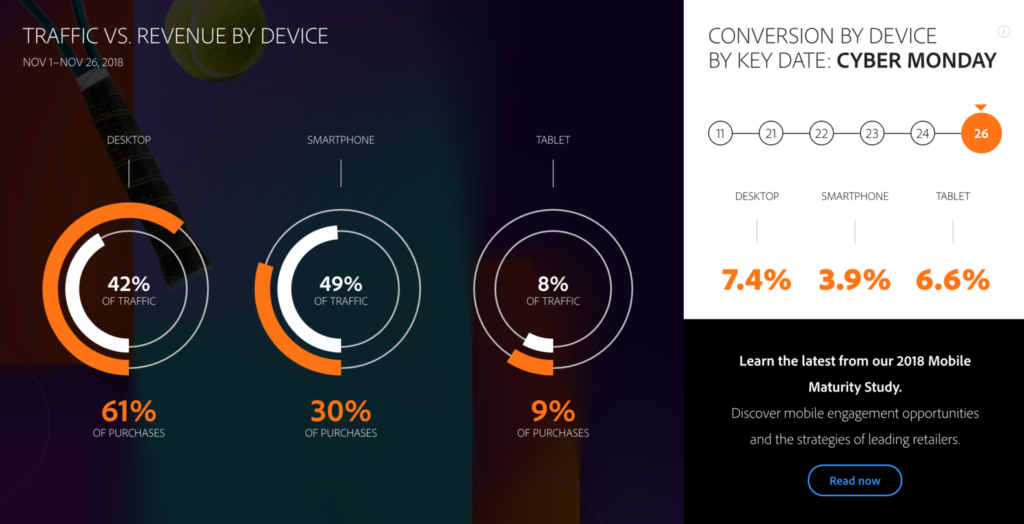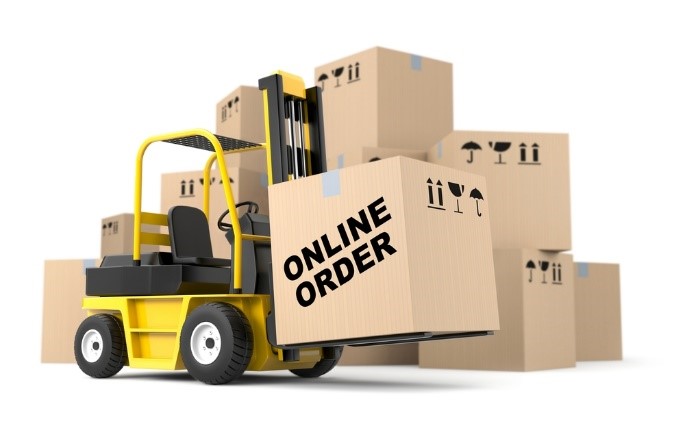
by Don Pingaro | Nov 28, 2018 | Commerce Strategy
At this very moment, retail executives around the US are likely screaming about their Black Friday and Cyber Monday sales performance. For some, these sounds resemble a triumphant war chant, for others, these are the shrill cries of defeat. The reason? Mobile-first adoption.
No matter where you stand, this data changes the eCommerce landscape. Here are the latest stats and key trends from the long-weekend of holiday sales events. We will update this article as soon as new data is released, so make sure you subscribe to be the first to know!
Thanksgiving Takes an Extra Helping
On Thanksgiving day, as of 7:00am Pacific Time, U.S. consumers spent $406 million. By 2pm, Adobe announced that this number skyrocketed to a whopping $1.75 billion, representing a 23% increase over sales in the same time period in 2017. By the end of the day, Americans beat out last year’s sales for the day by a shocking 28%, resulting in a shocking 3.7 billion dollar Thanksgiving. Adobe initially projected a $3.1B bottom line for the holiday.
Mobile Wins Big
Here’s a quick breakdown of the major events in bite-size chunks:
Thanksgiving Day
Black Friday
$2.1 billion or 33.5% of sales came from smartphones this Black Friday. Another 10% of sales, or roughly $627 million, came from tablet users. All in all, the day yielded an impressive $6.2 billion, a 23.6% increase over 2018.
Cyber Monday Breaks The Internet
Here’s the big one. Cyber Monday sales shattered all previous records for online sales… in U.S. history.
“Cyber Monday [topped] $7.9 billion by the end of the day, making it the largest online shopping day of all time in the U.S. This represents a 19.7 percent increase year-over-year (YoY) as of 7:00 p.m. ET. In comparison, Thanksgiving Day and Black Friday brought in $3.7 billion (28 percent growth YoY) and $6.2 billion (23.6 percent growth YoY) in revenue, respectively.”
BusinessWireHere’s the share of devices (as of ~1:30pm ET November 27, 2018):
 See more live stats at ExploreAdobe.com
See more live stats at ExploreAdobe.com
7 Days of Spectacular Sales
Additionally, Adobe’s latest report notes that this November has seen 7 days where total sales broke the $2 billion mark (as of Nov. 28, 2018)… Thanks in no small part to the mobile sales spikes.
Omnichannel Adoption Drives Sales
The trend of “buy online, pick-up in-store (BOPIS)” continued, with the trend growing 50% during this past weekend over 2018. According to Adobe, this spells dollar signs for omnichannel merchants: “As the online and offline retail experience continues to blend, retailers with physical stores drove 28 percent higher conversions online.” While this trend helped retailers increase their share of online earnings, in-store sales lagged far behind.
It’s time to join the mobile-first movement. As Adam Morris, Redstage CEO notes, “Cusotmers are no longer expecting an in-store Black Friday and Cyber Monday, but instead, an omnichannel experience.” While many retailers successfully ramped up their omnichannel strategies for this holiday, the data shows this trend is here to stay, and more work is needed.
If you want to reduce mobile checkout friction before the holidays are over, contact us asap! To see the results we’ve achieved with our recently launched Magento Community Initiative, find the latest data here.
Final Thoughts
These extravagant stats spell success for an industry racing to close the mcommerce gap. It’s seems the industry is all-aboard the mobile-first customer experience wave. As Internet Retailing points out, retailers may have finally reached ‘always-on‘ mobile consumers. Now it looks like the key areas for improvement are streamlining mobile checkouts, and optimizing omnichannel experiences.
Update Nov. 28, 2018
Black Friday + Cyber Monday Stats You Need To Know
Here’s a breakdown of YOY holiday sales by device and region based on data collected by our partners at Nosto!
-
- United States
Desktop: 39% (2017) / 34% (2018)
Mobile: 56% (2017) / 61% (2018)
Tablet: 5% (2017) / 3% (2018)
-
- United Kingdom
Desktop: 47% (2017) / 40% (2018)
Mobile: 42% (2017) / 48% (2018)
Tablet: 11% (2017) / 12% (2018)
-
- Northern Europe
Desktop: 39% (2017) / 37% (2018)
Mobile: 51% (2017) / 57% (2018)
Tablet: 10% (2017) 6% (2018)
-
-
- France
Desktop: 69% (2017) / 67% (2018)
Mobile: 19% (2017) / 22% (2018)
Tablet: 12% (2017) / 11% (2018)
- DACH
Desktop: 40% (2017) / 53% (2018)
Mobile: 42% (2017) / 39% (2018)
Tablet: 8% (2017) / 8% (2018)
Update Nov. 29, 2018
PayPal Mobile Payments Get A $2B Holiday Boost
-
- For the first time in PayPal history, mobile payment volume topped $1 billion, and did so on both Black Friday (November 23) and Cyber Monday (November 26). – PAYMNTS
-
- Adobe reports U.S. shopping carts averaged $138.00 during Cyber Monday, a 6% bump over last year.
-
- 49% of Black Friday traffic came from smartphones, driving 30% of online sales.
- “In the [PYMNTS] Checkout Conversion Index report, the 30 merchants with the fastest, most streamlined online checkouts ranked well. Conversely, the 30 merchants with the lowest scores offer a widely inconsistent checkout experience…”
Update Nov. 30, 2018
Cyberweek 2018 Trends Report
Our partners at BigCommerce identified a few additional trends in their Cyberweek 2018 Trends Report. Key findings include:
-
-
- While online stores continue to have the highest AOV for any sales channel, Facebook took second place, accounting for “70% of total GMV” for Fashion and Jewelry brands using the channel. Home and Garden brands selling on Facebook came in at 16% GMV.
- “The Fashion & Jewelry and Toys & Games verticals saw the highest GMV increases over 2017.

by Don Pingaro | Nov 21, 2018 | Commerce Strategy, System Integrations
The 2017 holiday rush was a tipping point for eCommerce optimization. Between mobile sales taking over traditional retail and other trends that took the industry by surprise, the holidays gave retailers myriad reasons to rethink digital strategy. Today, with Black Friday looming only days away, 2018 stands to be another make-or-break point for online sellers who did or didn’t adapt.
Our partners at Shoppimon put together this list of last-minute reminders for retailers prepping for the big week of sales ahead. Dive in to discover the top recommendations for managing traffic, guaranteeing uptime, and perfecting conversion optimization that just might save your store this season.
#1. Test the full sales funnel – from landing page to checkout.

The full sales funnel should be tested and optimized leading up to –and throughout– the holiday season. However, some key points of weakness that lead to significant business downtime are:
1. Search: 0.7% of all issues Shoppimon sees are problems with search. When search isn’t working on a website and shoppers can’t find what they’re looking for, it’s all too easy today to buy elsewhere.
2. Page Errors: Exposed error messages are surprisingly common. In fact, they’re responsible for 0.6% of all issues Shoppimon identifies. These pose a problem for several reasons. The first is that they stop the shopping process dead in its tracks. As a result, they also scare shoppers off. Not only are customer unable to complete a purchase, but after seeing an error message, they may lose all trust in the site going forward. Lastly, depending on the error, exposed messages can pose a serious security risk to a website… Ensuring these types of message don’t happen should be a top priority.
3. Error Message Text: To cover all your bases, make sure the language in your error messages is friendly and less automatic. This will let the customer know you are aware a problem is occurring, and that it may be fixed soon. “Error 506!” sounds a lot worse than “Hey there! We are experiencing a slight issue due to heavy site traffic. Check back in 15 minutes and the problem should be resolved. Happy holidays!”
4. Missing Product Images: If a shopper can’t see a product, they won’t buy it, end of story. Missing product images are surprisingly common. In fact, they make up 2.1% of all issues we spot. Understanding when this happens and fixing it before you lose a sale is a must. Monitoring your site will help keep you aware and in the know about missing product images and info.
5. Add to Cart & Checkout Errors: You are likely losing 4% or more of your total sales to issues occurring in these two key shopping stages. Issues here range from missing add to cart buttons to problems with payment providers. The average retailer will lose approximately 13% of sales to functional and performance-related website issues during the holidays. To avoid this, thoroughly test your conversion funnel and upgrade your website in advance of the seasonal surge. It can make a significant difference to your bottom line. If you’re out of time for a significant upgrade, monitoring your site closely and proactively address issues as they occur. It will have a dramatic and positive impact on your bottom line.
#2. Stress-test your site’s ability to handle increased traffic.

Under enough stress, every system will fail. Stress-testing your website before the holidays is a great way to find out if additional traffic could be your downfall. Leading up to Black Friday, we recommend you do both of the following:
1. Load Testing: making sure that your site can handle a given number of users/requests consecutively and concurrently.
2. Completing A True Stress Test: load the site to the point that it crashes to see how that crash is handled by your software (and potentially, your team).
When a site is overloaded, if a server is properly configured, it should be able to handle the benchmarked number of consecutive or concurrent requests, after which requests will be queued. If you then pass the benchmark for you queuing, requests should time out, rather than the site itself going down completely.
If your server does crash, splitting the load across other third party solutions like CDNs will help in the long run, so the servers don’t need to handle each and every request. However, if you need a last minute fix you can quickly tune the configuration of your servers to change the amount of memory they use. You may also be able to manage the number of requests they handle (assuming your code has been built to allows this).
#3. Be prepared to scale-up on the fly (and know how to).

The first thing an eCommerce manager should do is simply talk to their team. Understand what is already in place and what it would take to scale-up their web and database servers if needed. In an ideal situation, when a website is on a cloud platform, you should have deployment automation that allows you to quickly spawn more servers (which should only take a couple of minutes to complete). This does however require that automation is already in place to allow you to do this, and that the code was written in a way to support the expansion to additional hardware. And this is true not only of web servers, but database servers as well.
In a typical eCommerce setup, the biggest bottleneck is the database, which also tends to be the hardest to scale in an emergency situation. With limited time to prepare before Black Friday and Cybyer Monday, your top priority should be to check if your database hardware can scale if necessary. This is critical. If the situation arises where the database needs to be scaled and it wasn’t prepped in advance, it will usually result in significant downtime for the full site.
Going deeper into the issue, Redstage CEO Adam Morris states, “…when downtime occurs, or things do go wrong during the holidays, the effect of those issues is compounded because you’ve probably expanded your customer service team to make up for higher demand, as well as increased marketing budgets to attract more holiday spending. So when things go wrong, those marketing dollars are lost, and [customer] support may suddenly be relegated to a more junior team with less experience and a lower quality of service.” (Check out more insights on holiday emergency management from Adam Morris here on Shoppimon’s blog).
#4. Find problems before your customers do.

At Shoppimon, we see retailers monitoring their websites in a multitude of different ways; From manual checks conducted by different team members, to using completely automated systems like Shoppimon, and everything in between. Unfortunately, many of the systems require resource-heavy investments, not just for setup, but also to understand them and react to the data they generate.
While we know that monitoring automation is key for any business at scale, it’s important that a team’s resources spend as little time as possible on the monitoring itself. Instead, team members should be free to spend their time making a website or application better, fixing bugs, and creating a great customer experience.
Luckily, Shoppimon supports script-free and integration-free automated setup, which takes minutes. The solution also automates issue prioritization and notification, so users get critical information when it’s most needed, but never bothers them when it’s not.
These benefits have made a huge difference for our customers leading up to the holiday season. We’ve seen brands successfully roll out new updates and upgrades just before the sales surge, and also helped them identify better ways to plan for next year.
Each year we see the biggest challenges and successes of major brands in the eCommerce Industry. Last year, in our Online Store Health & Usability Index (OSHU Index), we saw brands like Birchbox, Dollar Shave Club and Saatva excel during the holiday season, with consistently faster load times and fewer issues both leading up to and during the holidays. However, we saw other retailers, like One King’s Lane, that experienced significant downtime during Cyber Monday, really struggle. The difference relies on your ability to react.
Final Thoughts:
Monitoring your online store for bugs and the ability to react quickly will determine the winners and losers for 2018. Testing is paramount (especially if you had issues last year), which means diving into your funnels, your site, and being prepared to tackle anything that needs fixing, fast. However, without a monitoring solution in place, you might not notice significant issues on your site causing lost revenue every minute. Do your due diligence and walk through each stage of the customer journey to make sure your holiday haul will be a happy one. Let us know what you think of these tips in the comments below, and enjoy the holidays!
For more insights on last-minute holiday strategies, check out this post from our partners at Brightpearl on omnichannel & backoffice prep!

by Don Pingaro | Oct 4, 2017 | Commerce Strategy, UX/UI Design
Did You See It Coming?

Earlier this month, IKEA emerged as the sleeper champ of retail’s augmented reality arms race. On the AI front, companies like Emarsys and Edgecase released eCommerce products that use advanced machine learning techniques to automate time-consuming data analysis and predictive forecasting strategies for retailers. With such tools available to manage mass audiences and their data, this is an opportunity for tech-minded shops to get a leg up on the competition. As a result, we can expect to see some large retailers (those who fail to adapt) fall behind in a relatively short amount of time. Survivors of this retail purge will make themselves known in the next year or two as these technologies become cornerstones of eCommerce. Here are some big changes to expect in the new paradigm of online shopping that everyone will be adding to next year’s budget.
“The IKEA Effect”
 Diving into Apple’s ARkit early-on, the home furniture & appliance giant successfully launched an AR app that lets users view how IKEA’s furniture will look in their home by selecting products from an online store. Released with iOS11, the brand was primed for a massive market reaction. Sure, the items still have some issues (they don’t adapt to lighting too well and their textures aren’t quite realistic), but as the first retail brand to jump into AR, the starting gun has been fired, and many companies are racing to capture value through this technology. Redstage CEO Adam Morris sees huge potential for AR in eCommerce, stating, “There’s certain industries that I see really benefiting from AR, especially companies where seeing the item in-person plays a huge factor. I believe jewelry sales could be completely revolutionized with AR, and then on to home goods like furniture.” However, Morris notes that the eCommerce industry typically lags a few years behind the latest tech trends, relying on major user adoption for companies to jump on the bandwagon. “For instance,” he recalls, “we talked about ‘mobile-first’ for years, well before companies would begin implementing it. Most didn’t pull the trigger until they had no choice — when mobile users made up more than thirty percent of their user base. It’s easy to argue that the industry is still doing a horrible job at mobile commerce, even now with roughly two-billion online shoppers using mobile.” Perhaps the companies that have been slow to catch up with mobile will double-down on AR, or risk giving up their market share to the brands that do. So what happens when health and beauty retailers jump onto this train? If Snapchat can already morph your face and add eye-shadow, will brands like Ulta Beauty and Maybelline step up to the challenge? How will consumers react to no-longer trying on makeup in-store, or to saving bundles of cash testing it through your app? Years down the line, this may even change the supply chain, because stores can test products without actually making them, without buying in bulk, and never worry about hemorrhaging money selling-off failed product. Will proactive make an AR filter to show what you’d look like without acne? Will Schick and Gillette face-off for a chance to show you how to carve up that beard? Furthermore, what will become of Snapchat, now that the company announced it will let brands create their own AR features? The possibilities are endless, and the brands that don’t engage AR or continue to view it as a passing trend will feel it in their bottom lines sooner or later. Watch: Snapchat’s Latest AR Project Puts Artwork All Over US Cities
Diving into Apple’s ARkit early-on, the home furniture & appliance giant successfully launched an AR app that lets users view how IKEA’s furniture will look in their home by selecting products from an online store. Released with iOS11, the brand was primed for a massive market reaction. Sure, the items still have some issues (they don’t adapt to lighting too well and their textures aren’t quite realistic), but as the first retail brand to jump into AR, the starting gun has been fired, and many companies are racing to capture value through this technology. Redstage CEO Adam Morris sees huge potential for AR in eCommerce, stating, “There’s certain industries that I see really benefiting from AR, especially companies where seeing the item in-person plays a huge factor. I believe jewelry sales could be completely revolutionized with AR, and then on to home goods like furniture.” However, Morris notes that the eCommerce industry typically lags a few years behind the latest tech trends, relying on major user adoption for companies to jump on the bandwagon. “For instance,” he recalls, “we talked about ‘mobile-first’ for years, well before companies would begin implementing it. Most didn’t pull the trigger until they had no choice — when mobile users made up more than thirty percent of their user base. It’s easy to argue that the industry is still doing a horrible job at mobile commerce, even now with roughly two-billion online shoppers using mobile.” Perhaps the companies that have been slow to catch up with mobile will double-down on AR, or risk giving up their market share to the brands that do. So what happens when health and beauty retailers jump onto this train? If Snapchat can already morph your face and add eye-shadow, will brands like Ulta Beauty and Maybelline step up to the challenge? How will consumers react to no-longer trying on makeup in-store, or to saving bundles of cash testing it through your app? Years down the line, this may even change the supply chain, because stores can test products without actually making them, without buying in bulk, and never worry about hemorrhaging money selling-off failed product. Will proactive make an AR filter to show what you’d look like without acne? Will Schick and Gillette face-off for a chance to show you how to carve up that beard? Furthermore, what will become of Snapchat, now that the company announced it will let brands create their own AR features? The possibilities are endless, and the brands that don’t engage AR or continue to view it as a passing trend will feel it in their bottom lines sooner or later. Watch: Snapchat’s Latest AR Project Puts Artwork All Over US Cities
The Fully Automatic Customer Journey
 Emarsys’ eCommerce platform is taking the world by storm. Using artificial intelligence to automate various customer retention and acquisition strategies, the AI uses machine learning to quickly create the perfect online shopping experience for each customer. Designed by Forrester, the system quickly crunches oceans of data about site visitors to cater to their needs and desires. After uploading two years of historical user data, eCommerce companies can maximize ROI on existing users. For new users, the Emarsys AI takes an average of 8 weeks to optimize the customer journey and activate recurring campaigns to keep engagement high. While there are many AI competitors out there, Emarsys boasts a robust, user-friendly platform that creates a truly personal experience for each shopper. As Morris describes it, “AI is becoming essential to work personalization into eCommerce, and machine learning systems offer huge advantages over rule-based systems. Marketers do not need to spend nearly as much time tweaking and administering a rule-based system when the AI is optimizing it automatically.” He adds, “We had a customer that doubled their newsletter list from 50k subscribers to 100k. However, since they did not employ any personalization strategies for what products were beingpresented, they only received a 15% increase in revenue from that channel.” As eCommerce threatens to surpass in-store sales (Business of Fashion) personalization of branded messages is critical. What are you doing to cater to each customer?
Emarsys’ eCommerce platform is taking the world by storm. Using artificial intelligence to automate various customer retention and acquisition strategies, the AI uses machine learning to quickly create the perfect online shopping experience for each customer. Designed by Forrester, the system quickly crunches oceans of data about site visitors to cater to their needs and desires. After uploading two years of historical user data, eCommerce companies can maximize ROI on existing users. For new users, the Emarsys AI takes an average of 8 weeks to optimize the customer journey and activate recurring campaigns to keep engagement high. While there are many AI competitors out there, Emarsys boasts a robust, user-friendly platform that creates a truly personal experience for each shopper. As Morris describes it, “AI is becoming essential to work personalization into eCommerce, and machine learning systems offer huge advantages over rule-based systems. Marketers do not need to spend nearly as much time tweaking and administering a rule-based system when the AI is optimizing it automatically.” He adds, “We had a customer that doubled their newsletter list from 50k subscribers to 100k. However, since they did not employ any personalization strategies for what products were beingpresented, they only received a 15% increase in revenue from that channel.” As eCommerce threatens to surpass in-store sales (Business of Fashion) personalization of branded messages is critical. What are you doing to cater to each customer?
Fringe Shoppers Beware
We all do it. We’ll aimlessly surf Amazon or another online retailer looking for something cool to buy, even when we don’t know exactly what we want. Edgecase, the company formerly known as Compare Metrics recently released a new product that helps convert shoppers who have a vague idea or even no idea of what they want. In a time where eCommerce and marketing penetrate the lives of every consumer, tools like Edgecase that help convert the shopping addicted masses are becoming hugely important. When integrated with an online store, the software makes selections for users based on what they’re thinking of (i.e. a blue dress in a certain size) rather than a specific brand. Users can also receive lists of recommended items when shopping for a specific event like a wedding or graduation. As we enter that special time of year, consider how a system built to convert fringe shoppers can have massive impact.
Final Thoughts
As the holiday season looms, companies taking advantage of AR and AI pose the biggest threat to your bottom line. As the eCommerce arms race ramps up, winners and losers will be defined by how they spend their 2018 budget. Make sure you’re planning to implement these tactics by next year’s holiday rush, or risk being left out in the cold.
Further Reading
+ Here’s five other ARkit projects that released with iOS11. + View Redtage’s outlook on the future of marketing & customer experiences. + Ten companies using machine learning in cool ways.

by Tandieka Johnson | Dec 1, 2016 | Commerce Strategy, System Integrations

With every new store display that goes up both in the physical and online stores, we are reminded the holidays are here. Online retailers put in a lot of effort to prepare their store for the holidays because of the potential increase in purchases (especially last-minute). The increase in customer traffic means there are potential increase in challenges; how you effectively deal with these challenges, can either make or break you to cement your online presence. Here are some of the challenges that you may face and how to address them:
#5: Increased website traffic
This is a great part of the holiday season but could have a negative effect on your store. It’s good because increased traffic can convert to increase in sales, however, unpredictable traffic could mean surges which may make your store go offline, something you obviously do NOT want to happen. To avoid this coordinate with your hosting company and your technology partners to ensure your disc space and bandwidth are increased appropriately. There are cloud hosting options and many other solutions to ensure that your store stays up and running during the holiday rush.
#4. Shipping Demand
The last thing your customers’ need to worry about is whether their items will be delivered on time. Not meeting your delivery schedule results in an unhappy customers who could take theirs and other business elsewhere. Evaluate your shipping options to see where it lacks and ensure it meets all potential customer demands. Any and all logistic issues with shipping products also increases your customer service requirements and taxes your staff causing mistakes and furthers the discontent of your customer base.
This doesn’t only effect small or medium sized eCommerce businesses. Just recently, we heard an internal story of a holiday related snafu with regards to Walmart. Their system shipped out a product incorrectly and it took a Redstage staff member 3 lengthy customer service calls to get it sorted out! This type of customer experience is why sites lose customers and what can stifle growth. Make sure your systems are running smoothly and your staff is trained to avoid these types of problems.

#3. Bad User Experience
Customer expectation for the look and ease of use of your online store can be very high. It is important to exceed this expectation to ensure that the user experience (UX) for the customer is memorable but most of all easy to use. Your products should be easy to find via navigation or search and contain enough product information to convince the customer to complete their purchase. Mobile optimization for your store is especially important in this day and age since a large percentage of shoppers use their mobile devices to shop online. Work closely with your web team’s designers and developers to optimize your store’s UX.
#2. Payment Fraud
The increase in online purchases during the holiday season also means you and your customers are more at risk to be victim to payment fraud. It is important to your customers to know that your website is secure since their card and bank information can be easily stolen if a merchant does not take the proper security measures. According to the National Retailer’s Federation, the average retailer loses 0.68 percent of revenue to fraud. This does not include the cost to you for fees, time and overhead and the loss of customer trust. Customer trust can cascade exponentially to ruin your brand and lose you much more than the industry average over time. To effectively manage this risk ensures that your store is in Payment Card Industry Security Standard Council (PCI) compliance, monitor customer daily transactions to look for any red flags in customer spending, use the address verification system and the Credit Card Verification Value (CVV).
Also, make sure that your software platform is up to date – We’re looking at you Magento 1.7 users! The security issues that can arise from out of date software need to be fixed immediately to protect you and your customers from hacking and fraud.

#1. Stock Control
It’s important to have sufficient stock to meet customer demand for the holiday season, it is also just as important to ensure you are not left with a large amount of holiday stock going into the new year. Make sure to monitory inventory ensure you have adequate amounts of stock for potential orders and storage is not an issue. Pull a report on your best-selling items in the last few months to ensure you’ve ordered the appropriate stock levels in time for Christmas. If you’re running any flash sales or pushing deeply discounted loss-leader items, you should have the data to support the inventory levels and not run low or end up with massive overstock.
Overall, these challenges aren’t impossible to overcome. If your company is facing any of these holiday difficulties or in general need any help or support with your store, please get in touch with Redstage anytime. You can reach us at 1-888-335-2747 or email us at info@redstage.com.
UPDATE!
Discover the top trends, insights, and strategies from the 2018 holiday season here!

 See more live stats at ExploreAdobe.com
See more live stats at ExploreAdobe.com











Recent Comments